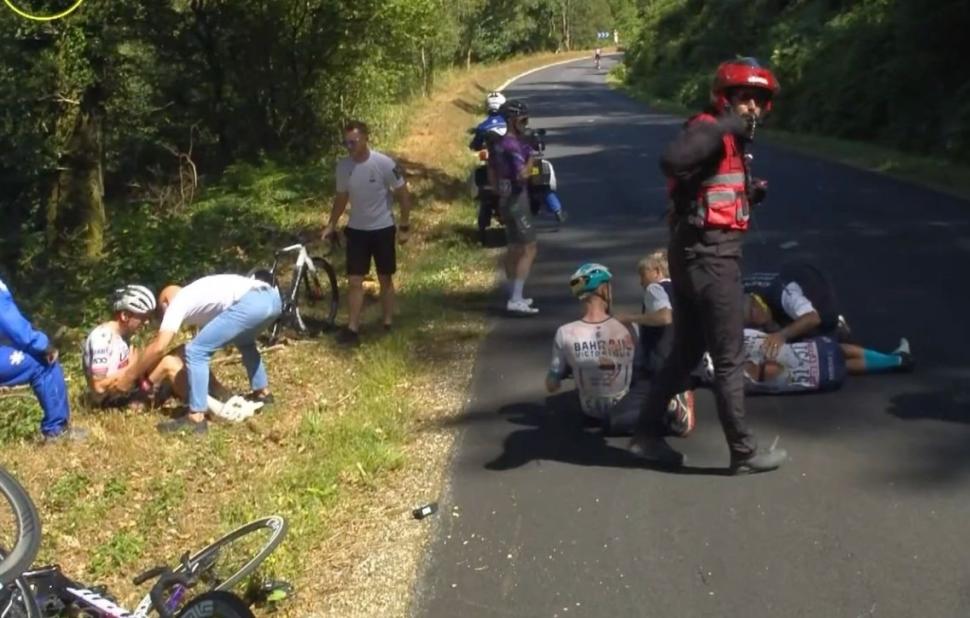As the Tour de France reached the end of its first week of racing in Mûr-de-Bretagne on Friday afternoon, two starkly contrasting images from today’s stage neatly summed up the opening seven days of racing. One, of course, was the now customary sight of world champion Tadej Pogačar raising his arms in celebration at a finish line, the Slovenian easily sprinting to his second win of this year’s race, and the 101st of his career, in the Breton town.
The other was the more sobering image of Pogačar’s key UAE Team Emirates domestique João Almeida, bloodied and battered, rib broken, jersey torn, one of the ten victims, alongside Jack Haig (who failed to finish the stage), Guillaume Martin, and Eddie Dunbar, of the latest high-speed crash at this year’s Tour de France.
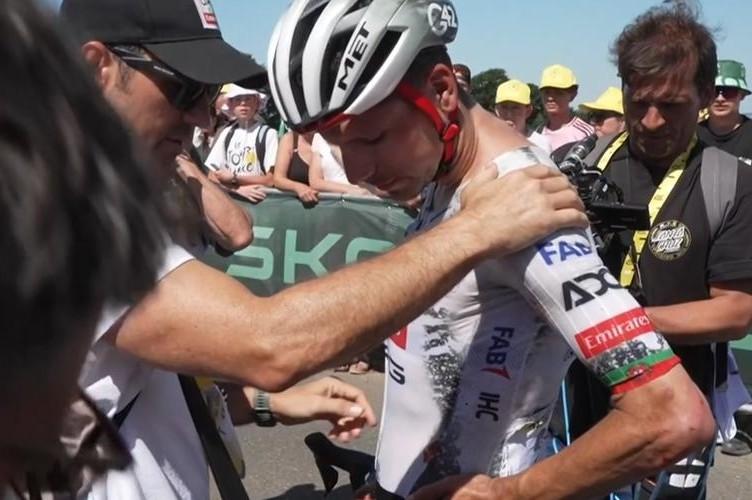 João Almeida crash, stage 7, 2025 Tour de France (credit: TNT Sports)
João Almeida crash, stage 7, 2025 Tour de France (credit: TNT Sports)
Unsurprisingly, the chaotic, fraught start to the Tour – a defining characteristic of the race’s first week, often synonymous with tension and crashes – has ensured that rider safety remains at the top of the cycling agenda, after a year marred by injuries and tragedy, as well as plans to overhaul equipment standards and reduce speeds in the peloton.
Earlier this week, Israel-Premier Tech’s Michael Woods criticised Tour organisers ASO’s pre-race safety presentation, which he claimed appeared to lay most of the blame for crashes on the riders themselves, telling them that they “must also take greater measures to reduce risks, and if they don’t, they may have to be forced to wear protective equipment in the future”.
In a lengthy blog post, former Tour stage winner Woods also devised his own four-point plan to make cycling safer, including scrapping the relegation system, which he says increases stress in the bunch, and reducing the size of the peloton, noting that the smaller bunch featured in the Olympics road race made it the safest event of last season.
The 38-year-old argued that speeds could be lowered by restricting bike and equipment design, and that steps should be taken to “reduce distractions”, such as the use of race radios and the modern trend of riders constantly looking at information on their bike computers.
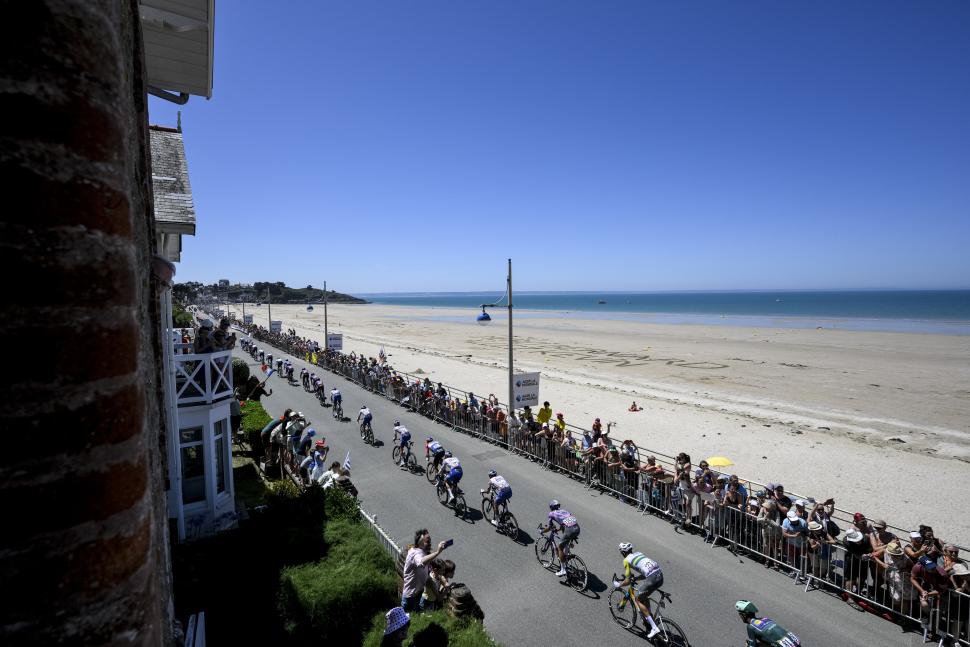 Stage 7, 2025 Tour de France (credit: ASO/Charly Lopez)
Stage 7, 2025 Tour de France (credit: ASO/Charly Lopez)
The build-up to the Tour was also punctuated by the UCI’s decision to introduce a raft of equipment changes, introduced ostensibly to deal with the “safety implications” of the increasing speed of professional races and thus increase safety.
The new rules – most of which are set to come into effect from next January – will see time trial helmets banned in road races, a maximum rim height set, a new fork width limit introduced, and, most controversially, the implementation of a new minimum handlebar width of 400mm.
Meanwhile, the governing body also announced that it will trial a new maximum gearing rule at the Tour of Guangxi in China in October, in another attempt to limit top speeds in the peloton.
This junior-style gear restriction, suggested by Wout van Aert earlier this year, will cap riders at a 54×11 gear ratio on 700c wheels, potentially hitting SRAM-sponsored teams hardest, as their 10-tooth cog setup will exceed the new limit.
> UCI to trial maximum gearing rule — but will it really make racing safer?
However, speaking in Lille this week at the Tour de France’s Grand Départ, the head of engineering at one of those SRAM-equipped squads Red Bull-Bora-Hansgrohe, Dan Bigham, argued that restricting gears will have no impact on speeds during races.
During the Science and Cycling Conference in Lille, reported by BikeRadar, Bigham – a former Hour Record holder and team pursuit world champion, famed for his understanding of aerodynamics and tech gains – presented his own analysis of the planned gear restrictions, which he argued were a distraction from the real changes that could be made to improve safety in pro cycling.
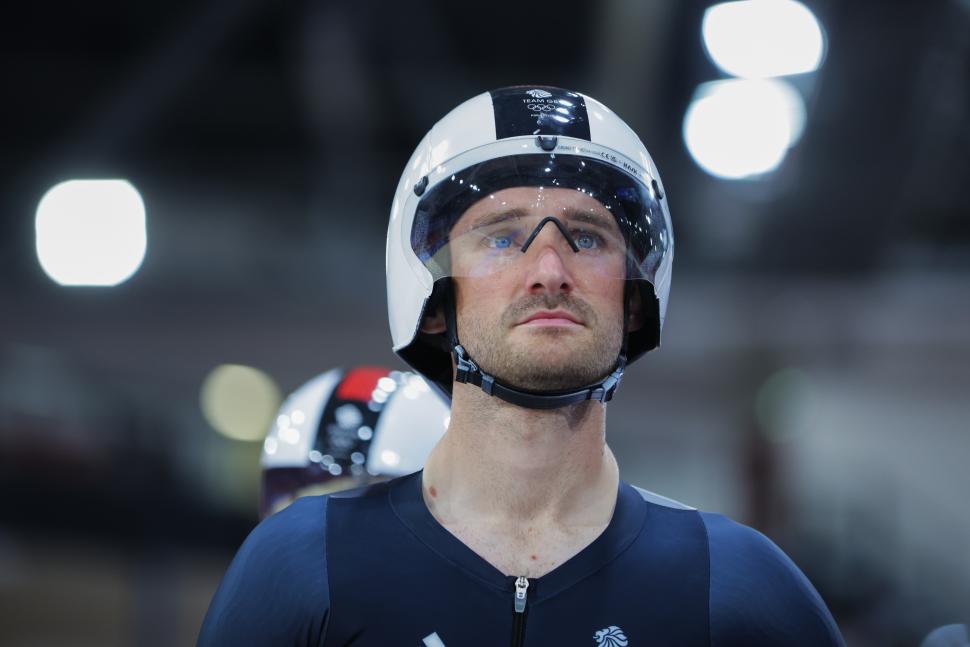 Dan Bigham, 2024 Paris Olympics (Ed Sykes/SWpix.com) (credit: road.cc)
Dan Bigham, 2024 Paris Olympics (Ed Sykes/SWpix.com) (credit: road.cc)
“If Wout van Aert, Tadej Pogačar or Mathieu van der Poel have a life-changing injury, or worse, we will have blood on our hands,” the 33-year-old said.
“We have the power to make changes. But restricting gear ratios simply distracts from making meaningful changes to rider safety.
“From my analysis, for reducing ratios to have an impact, we need to presume professionals would adhere to unrealistic cadence limits that aren’t supported by the literature.
“It’ll impact on as little as 0.01 per cent of a race and will arguably reduce speeds by no more than 0.5kph. All of this to change entire groupset design? It really doesn’t seem effective to me.”
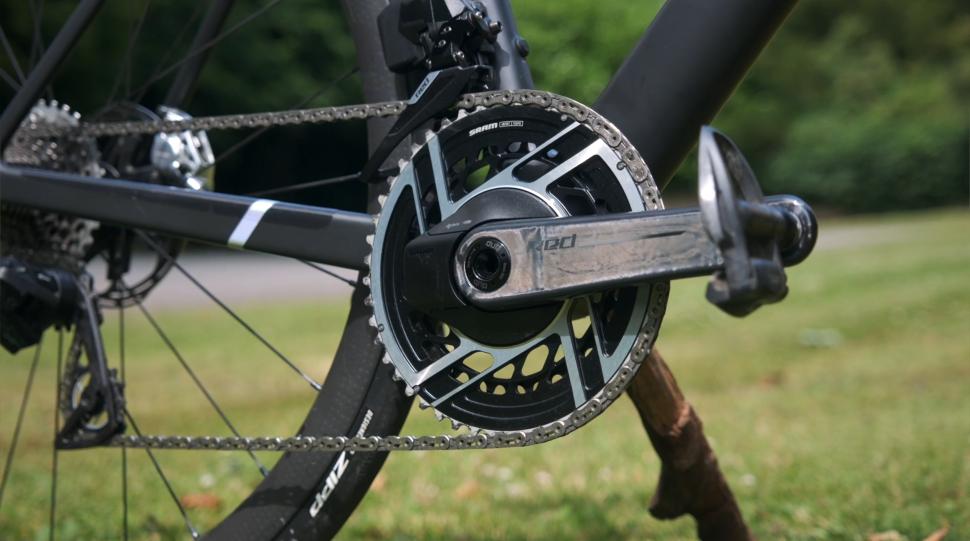 2024 midrange bike vs superbike sram red axs crankset (credit: road.cc)
2024 midrange bike vs superbike sram red axs crankset (credit: road.cc)
Referencing recent research by Kurt Bergin-Taylor, which showed an elite riders’ maximum cadence can reach over 200rpm, Bigham continued: “Whether you’re a GC rider or sprinter, if you want to limit a rider to 75kph and they can pedal at 200rpm, that means a gear ratio of three or less.
“So, will riders have to ride with – solely – a 30-tooth chainring? Even dropping cadence to 130rpm with a UCI ratio of five, you’d still ride at 80kph. But we know riders can do much higher than that for shorter periods.”
Assessing files from GC contenders at last year’s Giro d’Italia, Tour de France, Vuelta a España, and Tour of Guangxi, Bigham found that, at the 5.0 gear ratio stipulated by the UCI as part of its trial, riders would be gear limited – compared to a 5.6 ratio – for 1.1 per cent of the race at 120rpm, 0.34 per cent at 130rpm, and 0.1 per cent at 140rpm.
“What do we see? That riders don’t spend much time at high speed!” the Olympic silver medallist said.
He then pointed out that the highest speeds in races often happen on descents, where gravity – not gearing – is the most important factor.
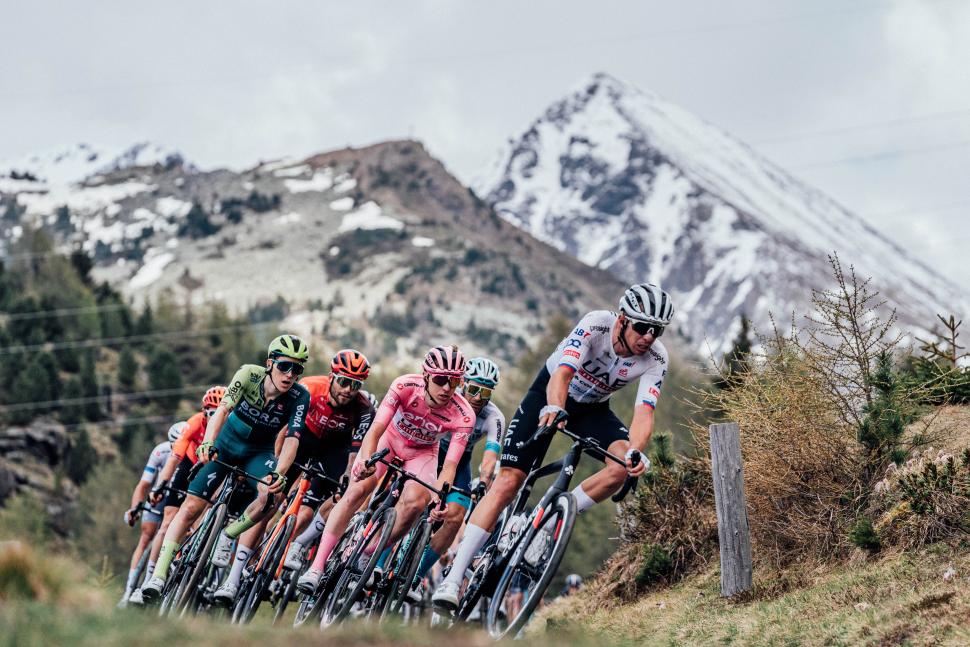 Tadej Pogačar, stage 15, 2024 Giro d’Italia (Zac Williams/SWpix.com) (credit: road.cc)
Tadej Pogačar, stage 15, 2024 Giro d’Italia (Zac Williams/SWpix.com) (credit: road.cc)
“The huge speeds happen on descents where you have huge input from gravity. If you’re on a 15 per cent descent and you weigh 80kg, that’s around 4,000 watts from gravity alone,” he said.
Riders descending at 75 to 90kph, Bigham noted, are putting in a maximum of 100 watts, which won’t be affected by gear restrictions, which will likely only affect an extremely small percentage of the race.
Bigham continued by arguing that the UCI’s gear restriction plan has the potential to focus solely on one small aspect of racing, without making any meaningful impact. Instead, the British engineer says cycling’s stakeholders should instead focus on four main “pillars” of safety: course design, bike design, rider protection, and medical response.
“We must use data to improve the situation,” he said. “Cycling is close to its Ayrton Senna moment. Ayrton died, and it changed things because he was a superstar.
“The FIA took it upon themselves to use science and data… Formula One has a lot to teach road cycling about going faster, but also about teaching us about safety.
“Take rider safety. We should have race-relevant helmet standards. But road-race helmets are tested at 20kph impact speeds. That’s not relevant or good enough.”
